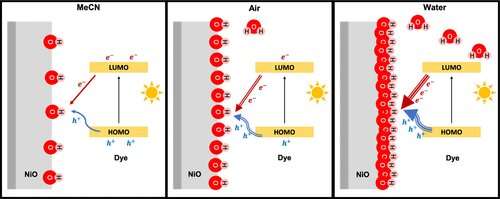Converting sunlight into fuel: Developing more efficient photocathodes

Photoelectrochemical cells are promising tools for the conversion of sunlight into fuel, for example, water into hydrogen, or CO2 into organic molecules. To realize this, a higher efficiency of the photocathode, often based on NiO, is needed. An important question is the role of water molecules adsorbed on the NiO surface. Research on the effects of this adsorption has been carried out by Kaijian Zhu, Ph.D. student in the team of Dr. Annemarie Huijser, Associate Professor in the Photocatalytic Synthesis Group at the University of Twente. The project is part of the Advanced Research Center Chemical Building Blocks Consortium (ARC CBBC; www.arc-cbbc.nl).
"In this work, we studied the light-induced processes occurring at the photocathode/electrolyte interface by advanced ultrafast spectroscopy." We show that hydroxyl groups formed at the NiO/water interface not only promote charge transfer between NiO and dye but also increase the rate of charge recombination. Both processes are considerably slower when the photocathode is exposed to acetonitrile, while intermediate behavior is observed in air. This study shows that more efficient photocathodes can be developed by optimizing the number of surface hydroxyl groups.
The article "Dual Role of Surface Hydroxyl Groups in the Photodynamics and Performance of NiO-Based Photocathodes," has recently been published in the Journal of the American Chemical Society.
More information: Kaijian Zhu et al, Dual Role of Surface Hydroxyl Groups in the Photodynamics and Performance of NiO-Based Photocathodes, Journal of the American Chemical Society (2022). DOI: 10.1021/jacs.2c04301
Journal information: Journal of the American Chemical Society
Provided by University of Twente



















